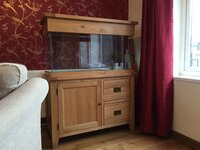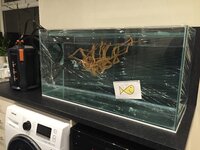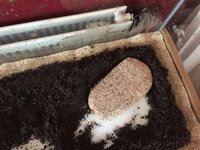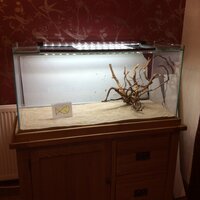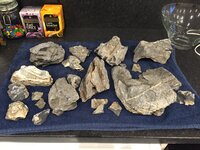Hi all,
I thought I'd start a journal of my new 200l AquaOak tank.
I've had my eye on an AquaOak tank for years as they match my living room furniture When I moved house I decided it was finally time to get one. I essentially went "Ooo pretty" and though it would make moving my existing fish easier.
When I moved house I decided it was finally time to get one. I essentially went "Ooo pretty" and though it would make moving my existing fish easier.
Maidenhead aquatics in knutsford were great and did me a deal on everything even though the tank was on sale at the time:
AquaOak 200l doors and draws
Aquamantia EFX 1000U filter
Aquamantia CH200 heater
Interpet 75cm triple led lighting
Having had mixed success with plants in sand in my other 100l river reef tank I wanted to get this one right. So I did I bit of research which led me to this site and the aquascaping experience. I came back from the event with some goodies, great advice and loads of ideas (and an overwhelming need to try creating a wabi kusa of my own!).
I'm now not sure about the lighting I bought, but I'm going to see how it goes and upgrade later if needed.
Substrate was my biggest concern. I wanted something good for the plants but also wouldn't be messy or mixed up by my fish. Cost was also a big factor. After reading the below thread I decided to go for a soil base (John Innes no.3) with retainer and capped with sand.
http://www.ukaps.org/forum/threads/the-soil-substrate-or-dirted-planted-tank-a-how-to-guide.18943/
Photos to follow shortly as I'm having trouble uploading them directly from my iPad.
Thanks for reading. Any advice is very welcome.
Maia
I thought I'd start a journal of my new 200l AquaOak tank.
I've had my eye on an AquaOak tank for years as they match my living room furniture
Maidenhead aquatics in knutsford were great and did me a deal on everything even though the tank was on sale at the time:
AquaOak 200l doors and draws
Aquamantia EFX 1000U filter
Aquamantia CH200 heater
Interpet 75cm triple led lighting
Having had mixed success with plants in sand in my other 100l river reef tank I wanted to get this one right. So I did I bit of research which led me to this site and the aquascaping experience. I came back from the event with some goodies, great advice and loads of ideas (and an overwhelming need to try creating a wabi kusa of my own!).
I'm now not sure about the lighting I bought, but I'm going to see how it goes and upgrade later if needed.
Substrate was my biggest concern. I wanted something good for the plants but also wouldn't be messy or mixed up by my fish. Cost was also a big factor. After reading the below thread I decided to go for a soil base (John Innes no.3) with retainer and capped with sand.
http://www.ukaps.org/forum/threads/the-soil-substrate-or-dirted-planted-tank-a-how-to-guide.18943/
Photos to follow shortly as I'm having trouble uploading them directly from my iPad.
Thanks for reading. Any advice is very welcome.
Maia


